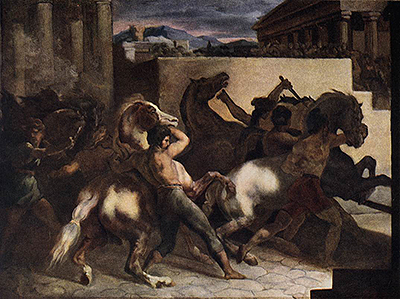Theodore Gericault was not long lived, but his output was impressive and stunning. A forerunner of the Romantics, in which beauty and nature (and natural beauty) was held to be Divine, a proof of God being all around us, his work is intense, dramatically lit and beautifully.
He loved to paint and draw horses and found, while escaping from classes with a tutor he disliked and found overly controlling, that he could come and go from the stables of the Palace of Versailles as he liked. He did like and spent many hours sketching and painting the beautiful creatures, excellent practise for many of his later works, such as this one.
The Race of the Riderless Horses is based on a genuine event that Gericault witnessed, in which riderless Barbary horses were encouraged to race each other down the Via del Corso (corso meaning race). Barbary horses were feisty and spirited animals and the riderless beasts galloping down the street would be unbroken and sometimes entirely unused to the presence of people. Carnival in Rome would end with the racing, but after an unwary spectator was trampled and killed in 1874 the practise stopped and the carnival itself went into decline (until recently, Carnival was resurrected in 2008!). However, while the practice was still in its heyday, the horse-loving Gericault saw the spectacle and was awed by the demonstration of power and might as the horses surged past, fighting for supremacy.
Planning to use the work as the basis of an even more immense canvas, Gericault lay this canvas out deliberately planting homages to symbolism and ancient Greek art. The whole picture, almost monochrome with a sepia wash, is reminiscent of Greek art works, and even the shape of the horses' heads has a stylised Grecian air. As much as the races were about seeing which horse would run the fastest or be the strongest in pushing through the crowds, Gericault also made this painting about the power of men to impose their will on nature.
Everywhere you look, the horses are being restrained, forced to wait until it is time to run. In a further nod to the ancient Greeks, Gericault has made them naked, as men were rumoured to perform in the earliest gymnasia. The men are well muscled, with details of muscle groups clearly identifiable on each limb, and this contrasts well with similar musculature on the depictions of the beautiful horses. This emphasises the notation that men, despite being smaller and supposedly weaker than horses, can impose their will on the beautiful creatures, before allowing them to flee away in a further display of strength and beauty.
The painting, created in 1817, just seven years before the artists untimely death at the age of 33, is currently in the possession of the New York Metropolitan Museum of Art, and was painted in oil on paper laid on canvas. It measures approximately eighteen by twenty-four inches.




